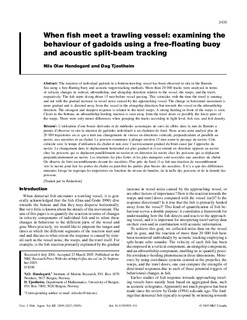When fish meet a trawling vessel: examining the behaviour of gadoids using a free-floating buoy and acoustic split-beam tracking
Journal article, Peer reviewed
Permanent lenke
http://hdl.handle.net/11250/108691Utgivelsesdato
2005Metadata
Vis full innførselSamlinger
- Articles [3012]
Originalversjon
http://dx.doi.org/10.1139/F05-131Sammendrag
The reaction of individual gadoids to a bottom-trawling vessel has been observed in situ in the Barents
Sea using a free-floating buoy and acoustic target-tracking methods. More than 20 000 tracks were analysed in terms
of velocity changes in vertical, athwarthship, and alongship direction relative to the vessel, the warps, and the trawl,
respectively. The fish starts diving about 15 min before vessel passing. This coincides with the time the trawl is running
and not with the gradual increase in vessel noise caused by the approaching vessel. The change in horizontal movement is
more gradual and is directed away from the vessel in the alongship direction, but towards the vessel in the athwarthship
direction. The strongest and sharpest response is related to the trawl warps. A strong herding in front of the warps is seen.
Closer to the bottom, an athwarthship herding reaction is seen away from the trawl doors or possibly the lower parts of
the warps. There were only minor differences when grouping the tracks according to light level, fish size, and fish density.
